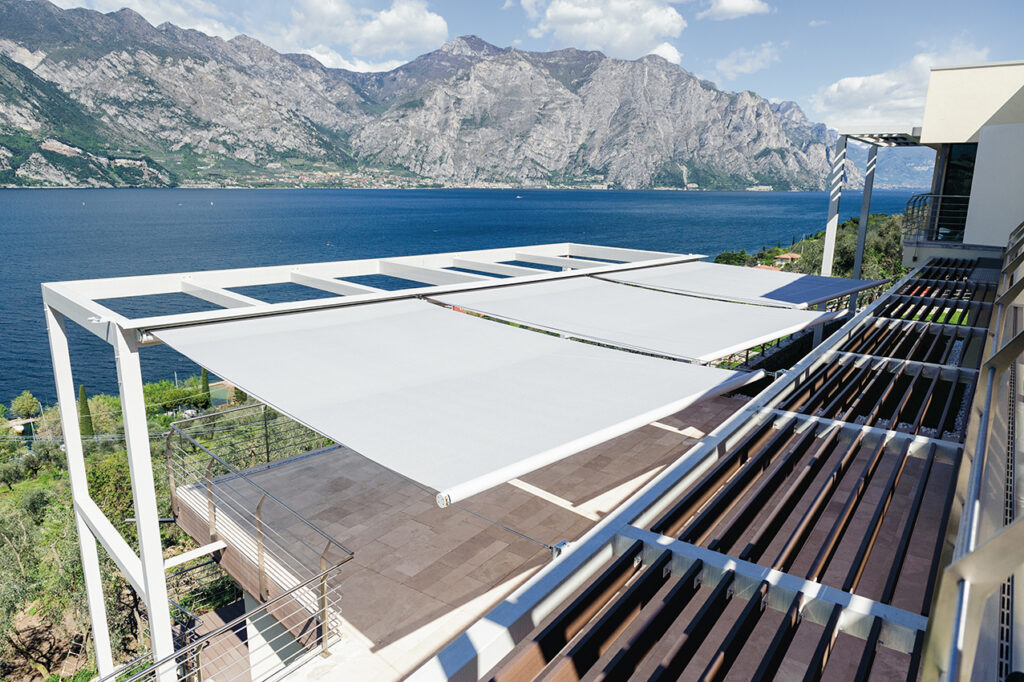
OUTDOOR SUNSHADES
Outdoor shades are those installed on balconies, terraces and in gardens. They can also be generally referred to as awnings, and can be manual or motorised, being useful for shading. There are many accessory components, such as the protective headbox, the remote control and so on, depending on the needs and tastes.
Outdoor awnings provide protection from the sun’s rays hitting the interior of the house and allow you to take advantage of open spaces such as terraces and gardens even in seasons with intense heat. Outdoor shades give the possibility of gaining additional space outside whilst also saving energy due to the reduced need for air-conditioners and fans. Depending on the models and types, they can also be used on rainy days, so long as they have a waterproof covering. Be they manual or motorised, small or extended, shades will always give an added extra, from an aesthetic point of view as well as from a comfort point of view.
OUTDOOR SUNSHADES: THE RIGHT DIMENSIONS
Outdoor awnings are created to protect from the sun’s rays, acting as a shield. Their dimensions depend on the space they have to cover but also on the space available for installation. Since coverage means the shadow that they will cast over the area, it is obvious that the panels must be larger, in terms of extent, than the space itself. There are various sizes on the market, with the standard starting from 3 metres wide. But if the measurements of the space are not standard, then contact a specialised company such as RESSTENDE to solve all sunshade needs, by availing of made-to-measure awnings. Important for the projection of the shade that the blind must give is the size of the arm on which it extends – from a minimum of 41.5 metres to much larger dimensions, it is possible to find the perfect sunshade for every space.
OUTDOOR SUNSHADES: WHAT KIND OF COVERING CAN BE ADOPTED?
Once the size has been determined, choosing the cover panel is a fundamental step. The quality, thickness, colour and material will determine the degree of protection that the outdoor shades will give from sunlight and/or rain. There are three macro types of fabrics for coverage:
POLYESTER COVERING
A shelter in polyester canvas is not the most suitable, given that polyester is very sensitive to UV rays and heat in general. This means that the duration will not be very extensive. This type of cover can be adopted when the sunshade is not subject to frequent use. It is advisable to protect the shade with a headbox when not being utilised.
ACRYLIC COVERING
An acrylic canvas cover is the ideal solution for heavily used external sunshades. The acrylic material is resistant to sunlight and is even waterproof. It offers a non-perishable and long-lasting shelter. The only drawback is that the acrylic material lets little air through.
MICRO-PERFORATED COVERING
The fabric is very resistant to heat and sunlight, does not tear easily and is able to even hold off water. What’s more, it is breathable and the micro-perforations allow air to pass through.
OUTDOOR SUNSHADES: FABRIC MAINTENANCE
Maintaining outdoor shades is a job that owes its difficulty to the characteristics of the fabric used. In general, they must be dusted regularly and once or twice a year, washed with detergent. Maintenance will be easier if the awnings are protected within a containment headbox.
Resstende’s outdoor shades are made with top-quality materials. The models are designed to respond to various architectural needs and blend harmoniously with the building structure. Resstende has created an extensive range of outdoor awnings with vertical, horizontal or tilted application. Elegant by design, with a high technical nature and excellent wind resistance distinguish Resstende outdoor shades. The quality of Resstende products has led the company to establish itself both in the national and international markets, exporting outdoor shades and all other products to over thirty countries around the world.





